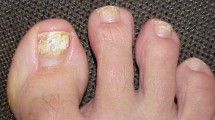Abstract
The purpose of this study was to determine the prevalence of causative non-dermatophytic filamentous fungi in onychomycosis. Totally 1,222 (1,222 × 3 = 3,666) samples of nail scrapings from 1,146 patients (from 76 patients two specimens: both from finger- and toe-nails) with prediagnosis of onychomycosis sent to the Mycology Laboratory from the Clinic of Dermatology, Ege University Hospital, Izmir, Turkey, July 2001–December 2003, were prospectively studied with conventional mycological procedures. The set criteria for the diagnosis of onychomycosis due to non-dermatophytic molds were: (1) Observation of fungal elements in 15% KOH-preparations made from nail scrapings, (2) growth of the same mold in all three consecutive cultures of the specimens taken three times from the same patient with one-week intervals, (3) no growth of a dermatophyte or yeast in three consecutive cultures. As agents of onychomycosis molds were detected in 33 (9%), dermatophytes in 175 (48%), yeasts in 150 (41%), and mixed (two different fungi) in 8 (2%) patients. In cases of mold onychomycosis, 11 (33%) had finger-nail and 22 (67%) toe-nail infection; 25 (76%) were female and 8 (24%) male; and 27 (82%) were above 40 years of age. The agents of mold onychomycosis, in order of frequency, were Aspergillus niger (7), Acremonium spp. (6), Fusarium spp. (6), Ulocladium spp. (4), sterile mycelia (2), Alternaria sp. (1), Aspergillus flavus (1), Aspergillus fumigatus (1), Aspergillus terreus (1), Cladosporium sp. (1), Paecilomyces spp. (1), Scopulariopsis sp. (1) and Trichoderma sp. (1). In conclusion, this study showed that non-dermatophytic molds were responsible for nearly 10% of onychomycoses cases attending the dermatology outpatient clinic of a university hospital in Izmir, Turkey. Since molds are common contaminants in the laboratory, cultures from consecutively taken nail scrapings should be made and carefully evaluated in order to diagnose a “mold onychomycosis”.
Similar content being viewed by others
References
H Velez F. Diaz (1985) ArticleTitleOnychomycosis due to saprophytic fungi. Report of 25 cases Mycopathologia 91 87–92 Occurrence Handle10.1007/BF00436541 Occurrence Handle2931605
JT Lim HC Chua CL. Goh (1992) ArticleTitleDermatophyte and non-dermatophyte onychomycosis in Singapore Australas J Dermatol 33 159–163 Occurrence Handle1303077
R Ramani CR Srinivas A Ramani TG Kumari PG. Shivananda (1993) ArticleTitleMolds in onychomycosis Int J Dermatol 32 877–878 Occurrence Handle8125689
G Ginter E Rieger K Heigl E. Propst (1996) ArticleTitleIncreasing frequency of onychomycoses – is there a change in the spectrum of infectious agents? Mycoses 39 IssueIDSuppl. 1 118–122 Occurrence Handle8767283
DH Ellis AB Watson JE Marley TG. Williams (1997) ArticleTitleNon-dermatophytes in onychomycosis of the toenails Br J Dermatol 136 490–493 Occurrence Handle10.1046/j.1365-2133.1997.d01-1222.x Occurrence Handle9155945
AK Gupta HC Jain CW Lynde GN Watteel RC. Sumerbell (1997) ArticleTitlePrevalence and epidemiolgy of unsuspected onychomycosis in patients visiting dermatologists’ offices in Ontario, Canada – a multicenter survey of 2001 patients Int J Dermatol 36 783–787 Occurrence Handle10.1046/j.1365-4362.1997.00349.x Occurrence Handle9372358
A Vélez MaJ Linares JC Fenández-Roldán M. Casal (1997) ArticleTitleStudy of onychomycosis in Córdoba, Spain: prevailing fungi and pattern of infection Mycopathologia 137 1–8 Occurrence Handle10.1023/A:1006874303991 Occurrence Handle9299751
JM Torres-Rodriguez N Madrenys-Brunet M Siddat O Lopez-Jodra T. Jimenez (1998) ArticleTitleAspergillus versicolor as a cause of onychomycosis: report of 12 cases and susceptibility testing to antifungal drugs J Eur Acad Dermatol Venereol 11 25–31 Occurrence Handle10.1016/S0926-9959(98)00040-3 Occurrence Handle9731962
C Gianni A Gerri C. Crosti (2000) ArticleTitleNon-dermatophytic onychomycosis. An underestimated entity? A study of 51 cases Mycoses 43 29–33 Occurrence Handle10.1046/j.1439-0507.2000.00547.x
MA Ghannoum RA Hajjeh R. Scher et al. (2000) ArticleTitleA large scale North American study of fungal isolates from nails: the frequency of onychomycosis, fungal distribution, and antifungal susceptibility patterns J Am Acad Dermatol 43 641–648 Occurrence Handle10.1067/mjd.2000.107754 Occurrence Handle11004620
H Järv P Naaber S Kaur M Eisen H. Silm (2003) ArticleTitleToe-nail onychomycosis in Estonia Mycoses 47 57–61 Occurrence Handle10.1046/j.1439-0507.2003.00947.x
AK Gupta T Gregurek-Novak N Konnikov CW Lynde S Hofstader RC. Summerbell (2001) ArticleTitleItraconazole and terbinafine treatment of some non-dermatopytic molds causing onychomycosis of the toes and a review of the literature J Cutan Med Surg 5 206–210 Occurrence Handle11685666
GE Canteros GO Davel W. Vivot (1994) ArticleTitleCausal agents of onychomycosis [Abstract] Rev Argent Microbiol 26 65–71 Occurrence Handle7938504
M Kiraz Y Yeğenoğlu Z Erturan Ö. Anğ (1999) ArticleTitleThe epidemiology of onychomycosis in Istanbul, Turkey Mycoses 42 323–329 Occurrence Handle10.1046/j.1439-0507.1999.00467.x Occurrence Handle10424104
C Liony P Joly X Balguerie T Fusade P. Lauret (1993) ArticleTitleCutaneous and nail infections caused by Hendersonula toruloidea Ann Dermatol Venereol 120 226–228 Occurrence Handle8239362
BE. Elewski (1996) ArticleTitleOnychomycosis caused by Scytalidium dimidiatum J Am Acad Dermatol 35 336–338 Occurrence Handle10.1016/S0190-9622(96)90664-7 Occurrence Handle8698921
AM Boisseau-Garsaud N Desbois ML Guillermin M Ossondo E Gueho D Cales-Quist (2002) ArticleTitleOnychomycosis due to Exophiala jeanselmei Dermatology 204 150–152 Occurrence Handle10.1159/000051836 Occurrence Handle11937744
S Nolting M Brautigam G. Weidinger (1994) ArticleTitleTerbinafine in onychomycosis with involvement by non-dermatophytic fungi Br J Dermatol 130 IssueIDSuppl. 43 16–21 Occurrence Handle8186136
A Tosti BM Piraccini C Stinchi S. Lorenzi (1996) ArticleTitleOnychomycosis due to Scopulariopsis brevicaulis: clinical features and response to systemic antifungals Br J Dermatol 135 799–802 Occurrence Handle10.1046/j.1365-2133.1996.d01-1083.x Occurrence Handle8977686
C Baykal R Kazancioğlu N. Büyükbabani et al. (2000) ArticleTitleSimultaneous cutaneous and ungual alternariosis in a renal transplant recipient Br J Dermatol 143 910–912 Occurrence Handle10.1046/j.1365-2133.2000.03808.x Occurrence Handle11071681
J Llovo E Prieto H Vazquez A. Muñoz (2002) ArticleTitleOnychomycosis due to Onychocola canadensis: report of the first two Spanish cases Med Mycol 40 209–212 Occurrence Handle12058734
Author information
Authors and Affiliations
Corresponding author
Rights and permissions
About this article
Cite this article
Hilmioğlu-Polat, S., Metin, D., İnci, R. et al. Non-dermatophytic Molds as Agents of Onychomycosis in Izmir, Turkey – A Prospective Study. Mycopathologia 160, 125–128 (2005). https://doi.org/10.1007/s11046-005-6872-z
Received:
Accepted:
Issue Date:
DOI: https://doi.org/10.1007/s11046-005-6872-z




